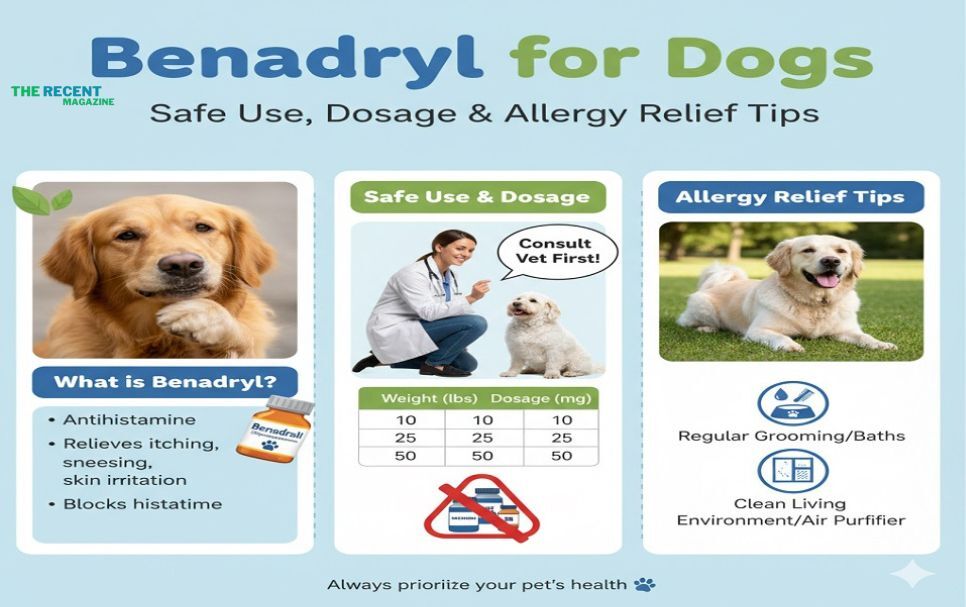Now Reading: Benadryl for Dogs: Safe Use, Dosage & Allergy Relief Tips
-
01
Benadryl for Dogs: Safe Use, Dosage & Allergy Relief Tips
Benadryl for Dogs: Safe Use, Dosage & Allergy Relief Tips

If your Benadryl for Dogs is scratching nonstop, sneezing, or seems restless during car rides, you might be wondering if Benadryl could help. You want to ease your furry friend’s discomfort quickly and safely, but how do you know if Benadryl is the right choice?
More importantly, how much should you give, and is it truly safe? You’ll discover clear answers to these questions, practical tips for using Benadryl with your dog, and what signs to watch out for. Keep reading to learn how you can help your dog feel better without risking their health.
Benadryl Uses In Dogs
Benadrylhelps dogs by easing allergy symptomslike itching and swelling. It blocks the chemicals that cause these reactions. For motion sickness, Benadryl can reduce nausea and dizziness during travel. Giving it before a car ride may help your dog feel calmer. Many dogs feel less anxiousafter taking Benadryl. It has a mild calming effect that can ease stress in noisy or new places. Always check the right dose with a vet to keep your dog safe.
Safe Dosage Guidelines
Consulting your vetis essential before giving Benadryl to dogs. Vets know the best dose and can check for health issues. Never guess the dose yourself. Each dog is different and needs a custom plan.
Dosage depends mainly on your dog’s weight. Usually, vets suggest 1 mg of Benadryl for every pound your dog weighs. For example, a 20-pound dog might get 20 mg. This helps avoid giving too much or too little medicine.
Avoid using human dosagesfor dogs. Human pills are not made for dogs and can cause harm. Use only Benadryl forms and amounts approved by your vet. This keeps your dog safe and healthy.
Administration Tips
Benadryl comes in tablets, capsules, and liquidforms. Tablets are easiest to measure and give. Liquid form suits small dogs or picky eaters. Avoid Benadryl with extra ingredients like pain relievers or decongestants.
Timing is key. Give Benadryl 30 minutes before allergy exposurefor best effect. Repeat dosing every 8 to 12 hours, but never exceed the vet’s recommended amount. Always use a proper measuring toolfor liquid Benadryl.
| Form | Benefits | Notes |
|---|---|---|
| Tablet | Easy to dose, convenient | Best for most dogs |
| Liquid | Good for small or picky dogs | Use proper measuring device |
| Capsule | Similar to tablets | May be harder to split dose |
Potential Side Effects
Common reactions to Benadryl in dogs include sleepiness, dry mouth, and mild stomach upset. Some dogs may feel dizzyor weak. Watch for vomitingor diarrhea, which can happen but are less common. These side effects usually pass quickly.
Signs to watch for include excessive drooling, trouble urinating, or rapid breathing. If your dog becomes very agitatedor has a swollen faceor lips, these are serious.
Seek veterinary help if your dog shows seizures, severe vomiting, or difficulty walking. Also, get help if symptoms last more than 24 hours. Do not wait or give more medicine without advice.
Precautions And Contraindications
Dogs with glaucoma, heart disease, high blood pressure, or seizuresshould avoid Benadryl. This medicine can make these conditions worse. Pregnant or nursing dogsalso should not use it without vet advice.
Benadryl can interact with other medicines like sedatives, antidepressants, or thyroid drugs. Combining these can cause serious side effects or reduce medicine effectiveness.
Do not use Benadrylif your dog is already very tired, weak, or has trouble breathing. Avoid it if the dog has narrow-angle glaucomaor is allergic to diphenhydramine.

Alternative Allergy Relief Options
Dogs with allergies may benefit from non-medication approaches. Regular baths with hypoallergenic shampoo can help remove allergens from the skin. Using an air purifier reduces airborne irritants at home. Offering a balanced diet rich in omega-3 fatty acids supports skin health and reduces inflammation.
Other antihistamineslike cetirizine or loratadine might be safe but always ask your vet first. These can help control allergic reactions without the sedative effects of Benadryl. Dosage varies by dog size and health, so proper guidance is important.
| Veterinary Treatments | Purpose |
|---|---|
| Allergy Shots (Immunotherapy) | Builds tolerance to specific allergens over time |
| Prescription Medications | Stronger relief for severe allergies |
| Topical Treatments | Reduces itching and skin inflammation |
Tips For Managing Benadryl for Dogs Allergies
Keeping your dog’s environment cleanhelps reduce allergy triggers. Regularly vacuum floors and furniture to remove dust and pollen. Avoid using strong-smelling cleaning products that may irritate your dog’s skin or nose. Keep windows closed during high pollen days to limit allergens indoors.
A healthy diet supports your dog’s immune system. Choose foods rich in omega-3 fatty acids and antioxidants, which can help reduce inflammation. Supplements like fish oil or probiotics may also improve skin health and reduce allergic reactions.
Schedule regular vet visitsto monitor your dog’s allergy symptoms. Early detection of issues like skin infections or ear problems can prevent worsening conditions. Your vet can recommend treatments or adjust medications as needed for better allergy control.
Frequently Asked Questions
How Much Benadryl Can I Give A Dog?
The typical Benadryl dose for dogs is 1 mg per pound of body weight, given 2-3 times daily. Always consult your vet first.
Can I Use Human Benadryl For My Dog?
Human Benadryl can be used for Benadryl for Dogs only under veterinary guidance. Dosage differs from humans and requires vet approval. Avoid multi-ingredient products. Always consult your vet before administering Benadryl to ensure safety and proper treatment.
How Much Benadryl For My Dog Calculator?
Calculate Benadryl dosage as 1 mg per pound of your dog’s weight, given every 8-12 hours. Always consult a vet first.
Is Benadryl Good For Dogs With Itching?
Benadryl can help relieve mild itching in dogs by reducing allergic reactions. Always consult a vet for proper dosage and safety. Avoid products with added ingredients. Monitor for side effects like sleepiness or upset stomach. Never use human dosing without veterinary guidance.
Conclusion
Benadryl can help dogs with allergies and itching safely. Always check with a vet before giving it. Dosage depends on your dog’s size and health. Avoid guessing doses or using human guidelines. Watch your dog for any side effects like sleepiness or upset stomach.
Proper care ensures your dog stays comfortable and healthy. Use Benadryl responsibly to support your dog’s well-being. Our all updete get to visit our website: therecentmagazine.com























